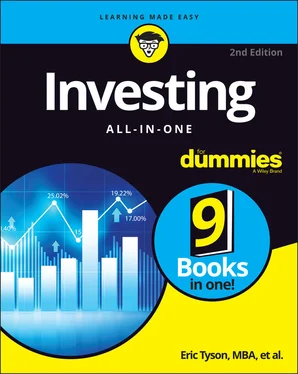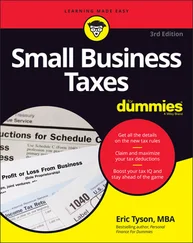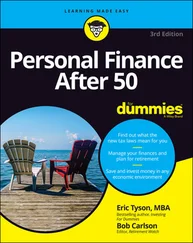Eric Tyson - Investing All-in-One For Dummies
Здесь есть возможность читать онлайн «Eric Tyson - Investing All-in-One For Dummies» — ознакомительный отрывок электронной книги совершенно бесплатно, а после прочтения отрывка купить полную версию. В некоторых случаях можно слушать аудио, скачать через торрент в формате fb2 и присутствует краткое содержание. Жанр: unrecognised, на английском языке. Описание произведения, (предисловие) а так же отзывы посетителей доступны на портале библиотеки ЛибКат.
- Название:Investing All-in-One For Dummies
- Автор:
- Жанр:
- Год:неизвестен
- ISBN:нет данных
- Рейтинг книги:3 / 5. Голосов: 1
-
Избранное:Добавить в избранное
- Отзывы:
-
Ваша оценка:
- 60
- 1
- 2
- 3
- 4
- 5
Investing All-in-One For Dummies: краткое содержание, описание и аннотация
Предлагаем к чтению аннотацию, описание, краткое содержание или предисловие (зависит от того, что написал сам автор книги «Investing All-in-One For Dummies»). Если вы не нашли необходимую информацию о книге — напишите в комментариях, мы постараемся отыскать её.
Investing All-in-One For Dummies
.
Dummies
Investing All-in-One For Dummies
Investing All-in-One For Dummies
Investing All-in-One For Dummies — читать онлайн ознакомительный отрывок
Ниже представлен текст книги, разбитый по страницам. Система сохранения места последней прочитанной страницы, позволяет с удобством читать онлайн бесплатно книгу «Investing All-in-One For Dummies», без необходимости каждый раз заново искать на чём Вы остановились. Поставьте закладку, и сможете в любой момент перейти на страницу, на которой закончили чтение.
Интервал:
Закладка:
Advisors who provide investment advice and oversee at least $100 million must register with the U.S. Securities and Exchange Commission (SEC); otherwise, they generally register with the state that they make their principal place of business. All advisors must file Form ADV, otherwise known as the Uniform Application for Investment Adviser Registration. This lengthy document asks investment advisors to provide in a uniform format such details as a breakdown of where their income comes from, their education and employment history, the types of securities the advisory firm recommends, and the advisor’s fee schedule.
 You can ask the advisor to send you a copy of his Form ADV. You can also find out whether the advisor is registered and whether he has a track record of problems by calling the SEC at 800-732-0330 or by visiting its website at
You can ask the advisor to send you a copy of his Form ADV. You can also find out whether the advisor is registered and whether he has a track record of problems by calling the SEC at 800-732-0330 or by visiting its website at www.adviserinfo.sec.gov . Many states require the registration of financial advisors, so you should also contact the department that oversees advisors in your state. Visit the North American Securities Administrators Association’s website ( www.nasaa.org ), and click the Contact Your Regulator link on the home page.
Chapter 2
Weighing Risks and Returns
IN THIS CHAPTER
 Surveying different types of risks
Surveying different types of risks
 Figuring out expected returns for different investments
Figuring out expected returns for different investments
 Determining how much you need your investments to return
Determining how much you need your investments to return
A woman passes up eating a hamburger at a picnic because she heard that she could contract a deadly E. coli infection from eating improperly cooked meat. The next week, that same woman hops in the passenger seat of her friend’s old-model car that lacks airbags.
Risk is in the eye of the beholder. Many people base their perception of risk, in large part, on their experiences and what they’ve been exposed to. In doing so, they often fret about relatively small risks while overlooking much larger risks.
Sure, a risk of an E. coli infection from eating poorly cooked meat exists, so the woman who was leery of eating the hamburger at the picnic had a legitimate concern. However, that same woman got into her friend’s car without an airbag and placed herself at far greater risk of dying in that situation than if she had eaten the hamburger. In the United States, more than 35,000 people typically die in automobile accidents each year.
In the world of investing, most folks worry about certain risks — some of which may make sense and some of which may not — but at the same time, they completely overlook or disregard other, more significant risks. This chapter discusses a range of investments and their risks and expected returns.
Evaluating Risks
Everywhere you turn, risks exist; some are just more apparent than others. Many people misunderstand risks. With increased knowledge, you may be able to reduce or conquer some of your fears and make more sensible decisions about reducing risks. For example, some people who fear flying don’t understand that statistically, flying is much safer than driving a car. You’re approximately 110 times more likely to die in a motor vehicle than in an airplane. But when a plane goes down, it’s big news because dozens and sometimes hundreds of people, who weren’t engaging in reckless behavior, perish. Meanwhile, the national media seem to pay less attention to the 100 people, on average, who die on the road every day.
Then there’s the issue of control. Flying seems more dangerous to some folks because the pilots are in control of the plane, whereas in your car, you can at least be at the steering wheel. Of course, you can’t control what happens around you or mechanical problems with the mode of transportation you’re using.
This doesn’t mean that you shouldn’t drive or fly or that you shouldn’t drive to the airport. However, you may consider steps you can take to reduce the significant risks you expose yourself to in a car. For example, you can get a car with more safety features, and you can choose to drive less aggressively and to minimize riding as a passenger with poor drivers.
Although some people like to live life to its fullest and take “fun” risks (how else can you explain mountain climbers, parachutists, and bungee jumpers?), most people seek to minimize risk and maximize enjoyment in their lives. The vast majority of people also understand that they’d be a lot less happy living a life in which they sought to eliminate all risks, and they likely wouldn’t be able to do so anyway.
 Likewise, if you attempt to avoid all the risks involved in investing, you likely won’t succeed, and you likely won’t be happy with your investment results and lifestyle. In the investment world, some people don’t go near stocks or any investment that they perceive to be volatile. As a result, such investors often end up with lousy long-term returns and expose themselves to some high risks that they overlooked, such as the risk of having inflation and taxes erode the purchasing power of their money.
Likewise, if you attempt to avoid all the risks involved in investing, you likely won’t succeed, and you likely won’t be happy with your investment results and lifestyle. In the investment world, some people don’t go near stocks or any investment that they perceive to be volatile. As a result, such investors often end up with lousy long-term returns and expose themselves to some high risks that they overlooked, such as the risk of having inflation and taxes erode the purchasing power of their money.
You can’t live without taking risks. Risk-free activities or ways of living simply don’t exist. You can minimize but never eliminate all risks. Some methods of risk reduction aren’t palatable because they reduce your quality of life. Risks are also composed of several factors. The sections that follow discuss the various types of investment risks and go over proven methods you can use to sensibly reduce these risks while not missing out on the upside that growth investments offer.
Market-value risk
Although the stock market can help you build wealth, most people recognize that it can also drop substantially — by 10, 20, or 30 percent (or more) in a relatively short period of time. That’s an example of market-value risk — that is, the risk that the value of an investment can decline.
Check out these historic stock market drops:
2020: After hitting a new all-time high in February 2020, the U.S. stock market got clobbered by COVID-19–related concerns and containment measures that impeded people’s travel and other activities and ended up leading to a sharp, short-term recession. In a little over one month, from peak to bottom, the Dow Jones Industrial Average plunged 36 percent.
2008: After a multi-year rebound, stocks peaked in 2007, and then dropped sharply during the “financial crisis” of 2008. From peak to bottom, U.S. and global stocks dropped by 50-plus percent.
2002: After peaking in 2000, U.S. stocks, as measured by the large-company S&P 500 index, dropped about 50 percent by 2002. Stocks on the Nasdaq, which is heavily weighted toward technology stocks, plunged more than 76 percent from 2000 through 2002!
1998: In a mere six weeks (from mid-July 1998 to early September 1998), large-company U.S. stocks fell about 20 percent. An index of smaller-company U.S. stocks dropped 33 percent over a slightly longer period of two and a half months.
1987: The U.S. stock market plunged 36 percent in a matter of weeks. On October 19, 1987, now known as Black Monday, the Dow Jones fell 508 points, the largest percentage drop in one day at that time.
Читать дальшеИнтервал:
Закладка:
Похожие книги на «Investing All-in-One For Dummies»
Представляем Вашему вниманию похожие книги на «Investing All-in-One For Dummies» списком для выбора. Мы отобрали схожую по названию и смыслу литературу в надежде предоставить читателям больше вариантов отыскать новые, интересные, ещё непрочитанные произведения.
Обсуждение, отзывы о книге «Investing All-in-One For Dummies» и просто собственные мнения читателей. Оставьте ваши комментарии, напишите, что Вы думаете о произведении, его смысле или главных героях. Укажите что конкретно понравилось, а что нет, и почему Вы так считаете.












